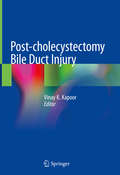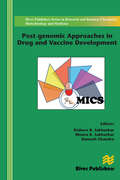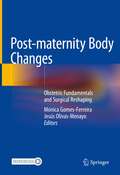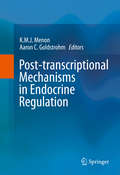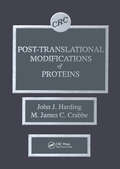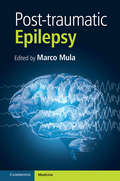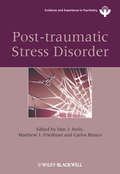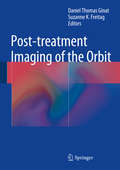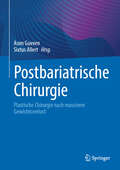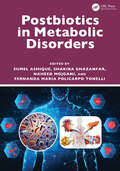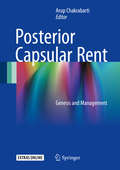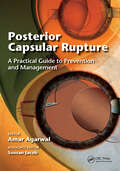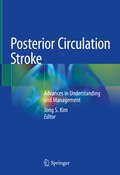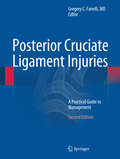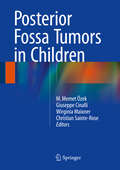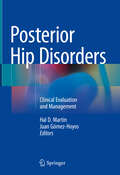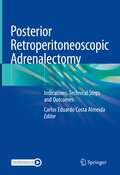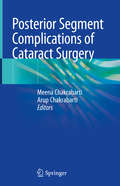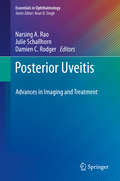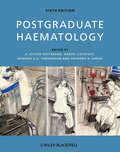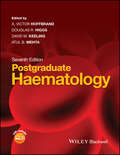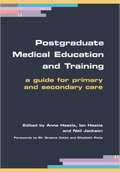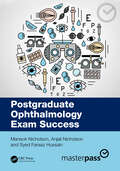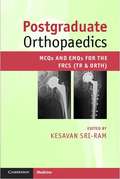- Table View
- List View
Post-cholecystectomy Bile Duct Injury
by Vinay K. KapoorThis book provides detailed insight to the readers into various aspects of bile duct injury. Bile duct injury is a common complication of cholecystectomy to treat gall stone disease prevalent all over the world. Risk of bile duct injury is more during a laparoscopic procedure as compared to open procedure and most cholecystectomies today are performed laparoscopically. Bile duct injury causes major morbidity and may even result in death, additionally it increases the healthcare costs and impairs quality of life. It is therefore important that every surgeon who performs cholecystectomy knows how to suspect, diagnose, manage and prevent bile duct injury. This book provides practical information and offers assistance in managing patients with difficult cases of bile duct injury. It summarises Dr Kapoor’s experience with management of more than 1,000 patients with post-cholecystectomy bile duct injury/ biliary stricture. Chapters cover anatomy, epidemiology, mechanism, pathophysiology, clinical presentation, investigations, classification, diagnosis, management and prevention of bile duct injury. It also includes non-medical issues including health care, socio-economic, costs and quality of life.
Post-genomic Approaches in Drug and Vaccine Development (River Publishers Series In Research And Business Chronicles: Biotechnology And Medicine Ser.)
by Ramesh Chandra Kishore R Sakharkar Meena K SakharkarOver the past decade, genome sequencing projects and the associated efforts have facilitated the discovery of several novel disease targets and the approval of several innovative drugs. To further exploit this data for human health and disease, there is a need to understand the genome data itself in detail, discover novel targets, understand their role in physiological pathways and associated diseases, with the aim to translate these discoveries to clinical and preventive medicine. It is equally important to understand the labors and limitations in integrating clinical phenotypes with genomic, transcriptomic, proteomic and metabolomic approaches. T
Post-maternity Body Changes: Obstetric Fundamentals and Surgical Reshaping
by Mónica Gomes-Ferreira Jesús Olivas-MenayoThis book is the first to assess the science and techniques used to restore women's figures after pregnancy and breastfeeding, and to explore the anatomical changes in different parts of the body. Post-maternity procedures are the result of a constantly evolving field at the intersection of gynecology and plastic surgery, and consist of a personalized set of surgical and non-surgical cosmetic treatments designed to help women to regain or improve upon their pre-pregnancy appearance. Leaders in the field shed new light on the science behind the natural changes to the body during and after pregnancy, helping readers understand which changes can be treated, and which ones should instead be respected. Divided into sections that anatomically assess the changes in the different parts of the body after pregnancy and breastfeeding, the book clarifies surgical procedures but also investigates the latest non-surgical treatments to improve women's body image. Moreover, readers will learn about the most relevant aspects of psychology and sexuality recovery treatment after pregnancy. Covering all aspects of the evolution and involution of the female body, the book offers essential information for those readers who want to learn about the changes accompanying pregnancy. It will also benefit residents and specialists in gynecology and plastic surgery, helping them understand how and why performing post-maternity procedures can be challenging for young and veteran doctors alike. In addition, it offers an important resource for fellowships in body shaping techniques and an invaluable reference guide for those readers who wish to specialize in post-maternity procedures.
Post-transcriptional Mechanisms in Endocrine Regulation
by Aaron C. Goldstrohm K. M. J. MenonThis book examines how post-transcriptional mechanisms control endocrine function. This includes newly identified regulatory mechanisms involved in hormone biosynthesis, control of hormone receptors and the outputs of hormone mediated signal transduction. Chapters address endocrine hormones including protein peptide/peptide, steroid, and non-steroidal hormones. The impacts of these mechanisms on disease and health are covered, providing a novel update to the scientific literature. Post-transcriptional regulatory mechanisms play an essential role in controlling dynamic gene expression. The outcome of this regulation includes control of the amount, timing, and location of protein expression. Regulation is mediated by cis-acting RNA sequences and structures and transacting RNA binding proteins and non-coding RNAs, including microRNAs. Recent advances in characterization of these regulatory factors have revealed enormous regulatory potential.
Post-translational Modifications of Proteins
by John J. Harding M. James CrabbePost-Translational Modifications of Proteins discusses several important topics of interest to researchers and students in protein chemistry and biochemistry, including the occurrence and function of hydroxylated residues and the three enzymes required for their formation; the damaging effects of reactions between sugars and proteins; ADP-riboosylation of proteins outside the nucleus; and Monod, Wyman, and Changeux's concerted model for allosteric control of enzyme activity exemplified by studies on glycogen phosphorylase. The application of Fast Atom Bombardment Mass Spectometry (FAB-MS) to studies on the structure and biosynthesis of various oligosaccharide moieties in protein is examined, and the understanding of the structural diversity and function of glycoprotein oligosaccharides is discussed in this volume.
Post-traumatic Epilepsy, Part 1
by Marco MulaEpilepsy is one of the most common neurological conditions, affecting up to seventy million people worldwide, with post-traumatic epilepsy (PTE) accounting for up to 20% of symptomatic cases. Despite this, there is a dearth of information about PTE available for clinicians. This book will guide readers through the neurobiology of PTE and the long-term consequences and rehabilitation needs of patients. Emerging topics such as concussive convulsions in sports are examined and a chapter dedicated to PTE in children ensures readers have the latest knowledge for treating this high-risk subpopulation. Managing PTE in medium and low-income countries where access to appropriate treatment, and even diagnostic equipment, is often poor, is covered in depth. This book is an up-to-date, comprehensive overview of PTE by active international authorities in the field of epilepsy and traumatic brain injury, with an emphasis on epidemiology, neurobiology, clinical problems as well as management issues.
Post-traumatic Stress Disorder
by Matthew Friedman Dan J. Stein Carlos BlancoDespite the growing interest in the role of psychological trauma in the genesis of psychiatric disorders, few volumes have addressed these issues from a multidisciplinary and international perspective. Given the complexity of reslience and posttraumatic disorder, and given ongoing trauma and violence in many parts of the world, it is crucial to apply such perspectives to review existing knowledge in the field and provide directions for future research.This book has a broad scope. A key focus is PTSD, because of its clinical and health importance, its obvious link with trauma, and its interest for many clinicians and researchers. However, the book also examines resilience and a range of mental health consequences of trauma, because it has become increasingly clear that not all individuals react to trauma in the same way. It is important for mental health professionals to be aware of the broad range of potential responses to trauma, as well as of relevant evidence-based treatments.The book includes chapters that address a wide range of topics on trauma-related disorders, including nosology and classification, epidemiology, neurobiology, pharmacotherapy, and psychotherapy. Each chapter comprises a critical review of the existing literature, aimed at being useful for the practitioner. This is followed by selected commentaries from other authorities on the topic, representing diverse geographical locations and points of view, who refine some of the perspectives offered in the review, provide alternative views, or suggest important areas of future work.
Post-treatment Imaging of the Orbit
by Daniel Thomas Ginat Suzanne K. FreitagThis book provides a comprehensive review of the imaging features that are seen following the application of a variety of ophthalmic and orbital procedures and therapies in patients with disorders affecting the cornea, retina, lens and ocular adnexa, as well as glaucoma. A wealth of high-quality radiographic images, including CT, MRI and ultrasound, depict expected post-treatment findings and appearances in patients with complications. In addition, correlations are made with clinical photographs and photographs of implanted devices. This reference has been prepared by experts in the field and should serve as a valuable guide to both radiologists and ophthalmologists, facilitating navigation of the intricacies of the treated eye and orbit and optimization of patient management.
Postbariatrische Chirurgie: Plastische Chirurgie nach massivem Gewichtsverlust
by Asım Gueven Sixtus AllertDieses Fachbuch stellt einen Leitfaden für Kolleginnen und Kollegen in der Plastischen Chirurgie dar, mit allen wesentlichen Informationen, um nicht nur die Zufriedenheit der Patientinnen und Patienten zu gewährleisten, sondern auch den Erfolg ihrer Klinik maßgeblich zu steigern. Es werden sämtliche operativen Behandlungsmöglichkeiten zur Straffung von Gesicht und Hals, über Abdomen und Gesäß bis hin zu Ober- und Unterschenkeln ausführlich beschrieben. Die "Postbariatrische Chirurgie" wächst kontinuierlich als dynamischer Teilbereich der Plastischen Chirurgie. Die Versorgung dieser Patientengruppe stellt nicht nur höchste Anforderungen an chirurgisches Geschick, sondern ist auch aufgrund der zahlreichen organisatorischen Herausforderungen seitens des Krankenversicherungssystems anspruchsvoll. Insbesondere in Zeiten knapper Ressourcen bei Personal und Budgets erweist sich ein effektives und effizientes Management dieser Patienten als unerlässlich. Dieses Buch richtet sich an erfahrene Kolleginnen und Kollegen der Plastischen Chirurgie, wie auch an Assistenzärztinnen und -ärzte. Ebenso werden Ärztinnen und Ärzte aus der Allgemein- und Viszeralchirurge mit Schwerpunkt Bariatrische Chirurgie von den fundierten Inhalten dieses Buches profitieren - und alle, die an diesem Fachgebiet interessiert ist.
Postbiotics in Metabolic Disorders
by Naheed Mojgani Fernanda Maria Policarpo Tonelli Sumel Ashique Shakira GhazanfarThis book discusses the role of postbiotics in human health. The initial chapter highlights the potential of postbiotics beyond traditional prebiotics and probiotics. Subsequent chapters present the beneficial effects on various health conditions, including cardiovascular disorders, cancer, diabetes, gestational diabetes, obesity, and mitochondrial disorders.The book covers the role of postbiotics in immune system modulation and inflammation-mediated metabolic disorders. It also explores the interaction of postbiotics with gut microbiota, detailing molecular mechanisms and signaling pathways. In addition, it offers current and future perspectives on postbiotics in human health, addressing their role in managing insulin resistance, glucose metabolism, metabolic endotoxemia, and inflammation in type 2 diabetes. The text provides an in-depth analysis of the impact of postbiotics on non-alcoholic fatty liver disease (NAFLD), lipid profiles, and hypertension. In addition, the chapters:1) Explore the promising concept of postbiotics and their potential beyond prebiotics and probiotics.2) Examine the beneficial effects of postbiotics on cardiovascular health, cancer, diabetes, and other conditions.3) Discuss the role of postbiotics in immune system modulation and inflammation-mediated metabolic disorders.4) Cover the interaction of postbiotics with gut microbiota, highlighting molecular mechanisms and signaling pathways.5) Analyze the current and future perspectives on postbiotics, including their impact on various metabolic disorders.This book is a useful resource for researchers and students of pharmacology and biotechnology.
Poster Child: A Memoir
by Emily RappEmily Rapp was born with a congenital defect that required, at the age of four, that her left foot be amputated. By the time she was eight she'd had dozens of operations and her entire leg below the knee had been amputated. She had also become the smiling, always perky, indefatigable poster child for the March of Dimes, and spent much of her childhood traveling around the Midwest making appearances and giving pep talks. All the while she was learning to live with what she called "my grievous, irrevocable flaw," and the paradox that being extraordinary was the only way to be ordinary. Poster Child is Rapp's unflinching, brutally honest and often darkly humorous account of wrestling with the tyranny of self-image as a teenager and then ultimately coming to terms with her own body as a young woman. It's about what it's like to live inside a broken body in a society that values beauty above almost everything else.
Posterior Capsular Rent
by Arup ChakrabartiThis book deals with a potentially sight threatening complication - rupture of the posterior capsule - during cataract surgery. This handbook covers the management of this problem from 3 perspectives: 1. Identifying patients at higher risk and measures to manage such patients by surgical discipline 2. Intraoperative management of posterior capsular rupture (PCR) to minimize long-term complications 3. Post-operative care for a patient who has a PCR Cataract surgery is the most commonly performed surgical procedure in ophthalmology and despite tremendous technical and technological advancements, PCR still occurs. PCR occurs both in the hands of experienced senior surgeons and the neophyte surgeons, although with a higher frequency in the latter group. Additionally, certain types of cataracts are prone to this development. If managed properly in a timely manner the eventual outcome may be no different from that of an uncomplicated case. However, improper management may lead on to serious complications with a higher incidence of permanent visual disability. Written for experienced and not-so-experienced eye surgeons alike to understand and manage PCR.
Posterior Capsular Rupture: A Practical Guide to Prevention and Management
by Amar AgarwalPosterior Capsular Rupture: A Practical Guide to Prevention and Management addresses a nightmare of every cataract surgeon: a posterior capsular rupture. The book details each aspect of the process, from prevention of a posterior capsular rupture to management and IOL placement. Dr. Amar Agarwal and his contributors, leading international ophthalmic surgeons, discuss the latest techniques in easy-to-understand text and format and include more than 250 high-quality photographs that enhance reader comprehension. Posterior Capsular Rupture: A Practical Guide to Prevention and Management presents a variety of complicated cases and complications such as posterior polar cataracts, IOL scaffold & glued IOL, sutured IOLs, management of dislocated IOLs, and corneal damage & posterior capsule rupture, to name a few.Additionally, a video website accompanies Posterior Capsular Rupture: A Practical Guide to Prevention and Management and allows readers to gain a better understanding of the subject. Practicing ophthalmologists, residents, and post-graduate students alike will benefit from this book’s clear portrayal of this difficult medical issue.
Posterior Circulation Stroke: Advances in Understanding and Management
by Jong S. KimThis book, written by renowned experts from across the world, provides readers with a detailed and up-to-date understanding of posterior circulation stroke and its management. Anatomy, pathophysiology, clinical syndromes, and imaging findings are clearly and thoroughly described with the aid of illustrative cases and schematic drawings. The management-oriented chapters explain all forms of treatment, including the use of antiplatelet agents and anticoagulants, thrombolysis, mechanical thrombectomy, stenting, and surgical therapy, i.e., bypass and decompression. Throughout, full account is taken of recent significant advances in knowledge and clinical practice. Stroke affecting the posterior circulation continues to pose particular challenges for clinicians. This book will help readers to avoid misdiagnosis, which still occurs far too frequently, and to manage individual patients optimally. It will be an excellent learning resource for residents in neurology, neurosurgery, radiology, interventional radiology, and vascular surgery, as well as an ideal reference for more experienced practitioners in these specialties.
Posterior Cruciate Ligament Injuries
by Gregory C. FanelliNow in a revised and expanded second edition including ten new chapters, this classic text on the diagnosis and management of posterior cruciate ligament injuries represents the state of the art. Comprehensive and used-friendly, the book covers PCL anatomy and biomechanics, diagnosis and evaluation, and both surgical and non-surgical treatment strategies. Surgical chapters discuss graft selection and open and arthroscopic techniques, including both primary and revision surgery and combined reconstruction with other knee ligaments. New chapters illustrate cutting-edge and advanced surgical techniques in reconstruction and primary repair, articular cartilage resurfacing and meniscus transplant in the PCL injured knee, mechanical graft tensioning, the role of osteotomy, treatment of PCL injuries in children, results of treatment and outcomes data in PCL injuries, clinical case studies, and the editor's experience chapter based on 24 years of treating PCL injuries. Complications, bracing and rehabilitation round out the presentation. Written and edited by leaders in the management of injuries to the knee, this will be an invaluable text for orthopedic surgeons and sports medicine practitioners alike.
Posterior Fossa Tumors in Children
by M. Memet Özek Giuseppe Cinalli Wirginia Maixner Christian Sainte-RoseThis book, written by experts from across the world, provides a comprehensive, up-to-date overview covering all aspects of posterior fossa neoplasms in pediatric patients, including medulloblastoma, ependymoma, cerebellar astrocytoma, atypical teratoid/rhabdoid tumor, chordoma, brain stem tumors, and rarer entities. For each tumor type, individual chapters are devoted to genetics, radiological evaluation using advanced imaging techniques, surgery, pathology, oncology, and radiation treatment. In addition, a separate section describes the various surgical approaches that may be adopted and offers guidance on the treatment of hydrocephalus and the role of intraoperative mapping and monitoring. Useful information is also provided on anatomy, clinical presentation, neurological evaluation, and molecular biology. The book closes by discussing in detail immediate postoperative care, the management of surgical complications, and longer-term rehabilitation and support. Posterior fossa tumors are the most common pediatric brain tumors but are often difficult to treat owing to their proximity to critical brain structures and their tendency to cause marked intracranial hypertension. Practitioners of all levels of experience will find Posterior Fossa Tumors in Children to be a richly illustrated, state of the art guide to the management of these tumors that will serve as an ideal reference in clinical practice.
Posterior Hip Disorders: Clinical Evaluation and Management
by Hal D. Martin Juan Gómez-HoyosThis unique and comprehensive text discusses the main causes of posterior hip pathology and recent advances in evaluation and treatment of those conditions, including posterior hip pain caused by discogenic, intrapelvic and extrapelvic disorders. Opening with description of the specific anatomy and biomechanics of the posterior hip and the etiology of hip disease, the next few chapters superbly discuss and illustrate the clinical, psychological and radiological assessment of the patient. Analysis with differential diagnosis of various causes of posterior hip pain, including nerve entrapment and impingement, is then presented in detail, followed by discussion of the essentials of the lumbopelvic complex as a source of pain. Later chapters cover vascular claudication as a cause of posterior hip pain, how to evaluate and manage the perioperative scenario, and physical therapy evaluation and treatment. Presenting the latest in examination, diagnostic tools, and surgical and therapeutic techniques from around the world, Posterior Hip Disorders is a solid resource for current and future generations of orthopedic surgeons, radiologists, physiatrists, spine surgeons, sports medicine specialists, rheumatologists, primary care physicians, and physical therapists.
Posterior Retroperitoneoscopic Adrenalectomy: Indications, Technical Steps and Outcomes
by Carlos Eduardo Costa AlmeidaThis book will offer for the first time a step-by-step description of the posterior retroperitoneoscopic adrenalectomy, a minimally invasive technique, moving the gold standard of laparoscopic adrenalectomy towards the retroperitoneoscopic approach. Detailed information about the technique, the advantages over other approaches, the technical steps, the potential complications and how to solve them, outcomes, and robotics, will be offered to readers. This practical guide will be of great interest for all general surgeons and urologists already performing adrenal surgery, and for those that wish to start performing adrenalectomy.
Posterior Segment Complications of Cataract Surgery
by Arup Chakrabarti Meena ChakrabartiPosterior segment complications of cataract surgery are encountered not only by the cataract and retinal surgeons but also by the general ophthalmologists in their daily practice. Yet, a definitive volume on this subject is not available. Written by experts in the field of cataract surgery and vitreoretinal surgery, this book is a comprehensive, updated practical guide on evaluation and management of patients with posterior segment complications following cataract surgery. This up-to-date reference covers all aspects of the field including evaluation of a patient, and all surgical procedures currently used in managing various complication in an organized systematic fashion. Necessary surgical modalities and approaches are thoroughly reviewed with ample illustrations for better understanding. Chapter dealing with surgical complications and failure has also been included in this book.
Posterior Uveitis: Advances in Imaging and Treatment (Essentials in Ophthalmology)
by Narsing A. Rao Julie Schallhorn Damien C. RodgerThis comprehensive text provides readers with an in-depth examination of posterior uveitis, and expert instruction on diagnosis, imaging techniques and treatments that are being reshaped by advancements in the field. Posterior Uveitis: Advances in Imaging and Treatment focuses on the ocular imaging modalities used in the diagnosis of various uveitis and intraocular inflammation entities resulting from infectious and non-infectious etiologies. Each topic is succinctly presented by experts in the field of intraocular inflammation and ocular imaging and starts with salient clinical features, differential diagnosis and specific treatment, and concludes with in-depth and relevant clinical imaging findings. The book opens by touring a multitude of infectious and non-infectious uveitidies and explores how advances are aiding our diagnosis and treatment. The second half will delve into established and emerging therapeutics, including advances in drug delivery. Evolving treatments for recalcitrant uveitis are discussed, including the newer biological agents, and each chapter includes ample illustrations and several tables for readers to comprehend with ease the inflammatory disorders and to interpret the imaging changes in various uveitis entities.
Postgraduate Haematology
by A. Victor Hoffbrand Daniel Catovsky Anthony R. Green Edward G. TuddenhamThe textbook of choice for trainees and practitioners in haematologyOver five editions Postgraduate Haematology has built a reputation as an extremely practical, user-friendly, reliable source of information for examination preparation and clinical practice. Completely revised to reflect the latest research in the field, this edition continues to provide trainees with up-to-date knowledge on the pathogenesis, clinical and laboratory features, and management of blood disorders. It covers the significant advances which have occurred in the application of cytogenetics and molecular genetics in the diagnosis, classification and understanding of haematological disorders.Coupled with the expertise of 34 new contributors from across Europe, the editors have been joined by Professor Anthony Green, from the University of Cambridge, and they have reorganised the book into 52 accessible chapters.Postgraduate Haematology is richly illustrated throughout with over 450 colour illustrations including line drawings, photomicrographs of blood cells and tissues, and algorithms to help aid treatment decision making. It is an indispensable resource for trainees and an essential read for all specialists who are interested in updating their knowledge.Companion resources site for this book:www.wiley.com/go/hoffbrand/postgraduatewith:Figures and tables from the book for downloadingInteractive multiple-choice questions
Postgraduate Haematology
by Douglas R. Higgs Victor Hoffbrand Atul B. Mehta David M. KeelingPostgraduate Haematology provides up-to-date knowledge of the pathogenesis, clinical and laboratory features, management and treatment of a wide range of blood and bone marrow disorders in a concise and user friendly style. Up-to-date knowledge of the pathogenesis, clinical and laboratory features and management of all blood disorders New sections reflect advances in the specialty, including knowledge gained from new generation sequencing, latest anticoagulant drugs, diagnostic laboratory tools, and treatment strategies Superb four-color illustrations and photomicrographs of blood cells and tissues throughout Includes algorithms to aid with decision-making for treatment Companion website includes figures and tables for download
Postgraduate Medical Education and Training: A Guide for Primary and Secondary Care
by Neil Jackson Anne Hastie Ian HastieThis is an exploration of how the higher functions of the brain can be investigated, evaluated and, possibly, explained. A central theme throughout the book is rationality, since issues requiring rational evaluation confront many people everyday though emotional factors are often more influential in determining action. The book looks at various questions: is it possible to understand what is going on in someone else's mind?; why do people who are known very well often react irrationally, in a totally different way to what is expected?; what are emotions, beliefs, feelings and desire? Throughout, episodes from history involving famous artists and politicians are used - Gladstone and Lincoln, Bach and Graupner, Austen and Dickens - all providing useful examples to illustrate how rationality can provide an insight into the feeling self.
Postgraduate Ophthalmology Exam Success (MasterPass)
by Maneck Nicholson Anjali Nicholson Syed Faraaz HussainThis book serves as a core revision resource for candidates preparing for ophthalmology exams, presenting content in a clear and logical format. It covers ophthalmic instruments, surgical steps, while also addressing related viva voce questions, including surgical techniques and potential complications. Ophthalmic specialist trainees, residents, and specialty doctors will find this guide essential for revising oral and clinical-based exams in ophthalmology.Key features: Comprehensive coverage of ophthalmic instruments, including a groundbreaking section on OPD instruments and an in-depth description of surgical instruments with corresponding viva questions Includes a dedicated section on sterilization techniques, ensuring a thorough understanding of best practices Offers invaluable guidance to trainees and residents on presenting answers clearly, succinctly, and confidently Emphasizes crucial yet often overlooked topics, in a viva voce
Postgraduate Orthopaedics
by Kesavan Sri-RamWhat do you need to do before sitting the written component of the FRCS (Tr and Orth) examination? Practice, practice, practice. Sadly the MCQs and EMQs in the actual examination are not this straightforward. This book will help the orthopaedic surgeon preparing for the written part of the examination to be ready to face the task ahead. The MCQs and EMQs appear in the same format as the examination and cover the syllabus topics. Divided into subspecialty chapters, including trauma and basic science, this book is ideal for use alongside a revision plan. The questions have detailed answers and selected references, arming readers with the knowledge they need to approach the topic correctly. Written by recent, successful examination candidates, this question-and-answer-based revision guide is ideal preparation for the FRCS (Tr and Orth) examination as well as being helpful for other postgraduate orthopaedic exams.
